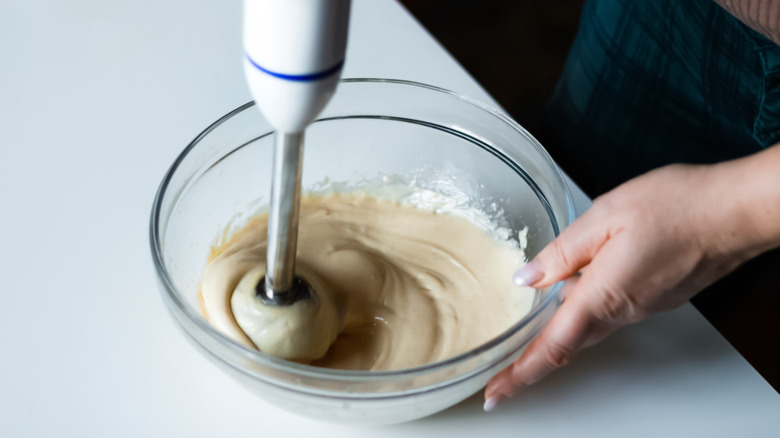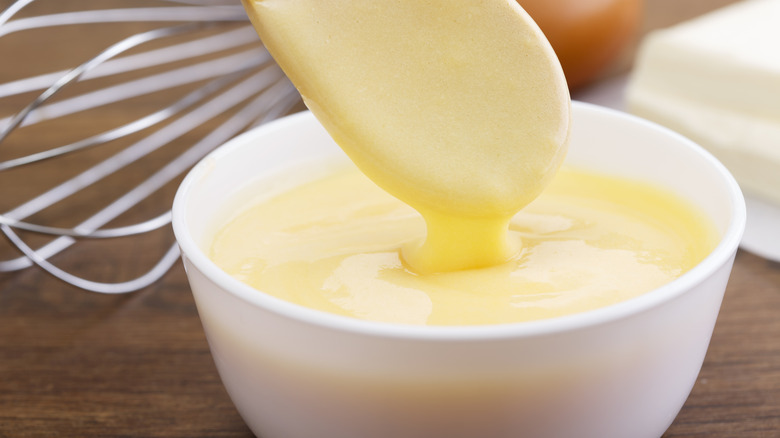What Kinds Of Recipes Have Emulsions, And How Do You Fix A Broken One?
When you're crafting sauces, a fundamental process to know is emulsion. The term refers to a combination of liquids that's not usually stable but holds via an external agent, whether it be vigorous mixing or another ingredient. You'll find these delicate compositions in many dishes and even household ingredients.
Mayonnaise, salad dressing, egg-based sauces, a roux, chocolate, or even milk are all examples of emulsions. The concept is straightforward enough — one type of molecule is suspended in another — but knowing how to work with them is tricky. Some combinations emulsify easily, such as those in mayo, a batch of homemade ghee, or freshly blended pesto. However, others are a pesky source of frustration. There's the easily curdled hollandaise, too-often split ganache, or a roux-based sauce that just won't hold. Knowing what factors go into sauces — and their impact on emulsification — will let you both whip up and fix these creations with ease.
Common ingredients that act as emulsifiers
Emulsification requires both technique and a specific set of components. Certain foodstuffs — called emulsifiers — are crucial to the process. Possessing an intricate chemical composition, they tie together repellent fat and water molecules. As you might expect, some of these compounds have intimidating, industrial-sounding names. For instance, there's seed-extracted lecithin, which is used to emulsify plant-based milks, or polysorbate, used in soft drinks.
However, other emulsifiers are pantry staples, and you likely already have some on hand. Egg yolks are especially powerful emulsifiers, hence their foundational nature in so many sauces. Containing lecithin, egg yolks are the magic binder in hollandaise, mayo, and many other sauces. Respect their importance by adding the employed fat into the egg yolks rather than the other way around. If your sauce breaks, slowly stir the mixture into fresh egg yolks to recombine it. The process will be even more effective with a dash of lemon juice alongside the yolk.
Other underrated emulsifiers include honey, mustard, garlic, and tomato paste. These are especially effective with dressings; they'll both flavor and reform the mixture. They're also a wonderful way to spice up a broken homemade aioli, integrating both enhanced texture and taste. Furthermore, an emulsified mixture like mayonnaise can itself work as an emulsifier and reform a broken sauce.
Extra force and temperature reductions can also fix emulsions
Emulsification isn't only about the ingredients; it's also about technique. Most prominently, you'll need some agitation — it'll spread all of those fat molecules throughout the water. This means elbow-tiring whisking or a whir in the blender.
Don't neglect the power of an extra dose of mixing with a broken sauce. Break out the immersion blender to stiffen up a mayonnaise or speedily thicken a delicate sauce. Give a salad dressing more whisking — especially with an aforementioned emulsifying ingredient — and it'll reform. Or, simply throw the entire mixture in the blender for a more intensive approach. Just note that you don't want to blend in too much oil at once; this ingredient needs to be slowly dispersed.
Temperature also impacts emulsions; it's what commonly breaks a hollandaise sauce. Heat sauces too much, and the egg proteins will curdle or the fat will separate. It's wise to emulsify something with a thermometer in hand. If you just barely overheat it, take it off the heat and stir in some cold water — it might fix the sauce. With delicate compositions like ganache, always have an ice water bowl nearby for cooling. However, go too far with heating any emulsion, and you'll need to start over. Keep in mind that since emulsified compounds are temperature-sensitive, be wary of using them into applications that involve further heating.


